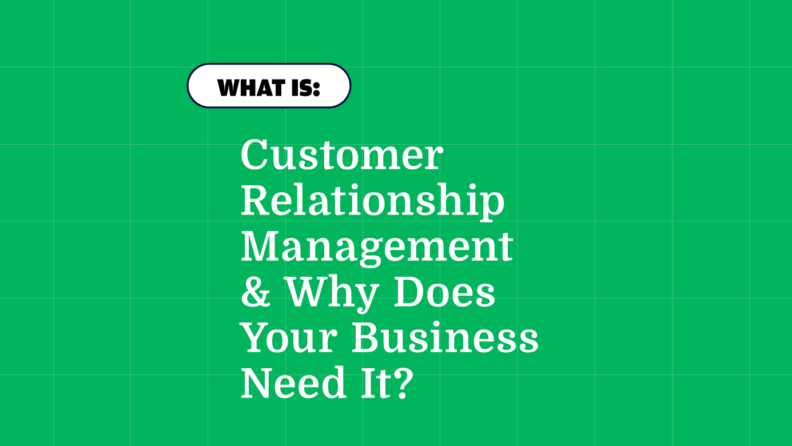Do feel like your customer data is scattered across a dozen different spreadsheets and sticky notes? Has a potential customer contacted your team with a question, but you couldn’t find their purchase or communication history? Without a Customer Relationship Management (CRM) system in place, these problems will only get worse as you scale.
Lucky for you, I’ve outlined how you can set up a better process and the CRM software you’ll need to do it below. Ready? Let’s go.
What is Customer Relationship Management (CRM)?

CRM is both strategy and software that helps businesses manage and improve their interactions with buyers across the entire customer lifecycle.
A CRM system acts as a central hub, storing customer data, communication history, and purchase information. Most CRM software offers a suite of functionalities to streamline processes, personalize interactions, and ultimately build stronger customer relationships.
Without a CRM system, you’ll likely face:
- Lost customer data: Important customer information gets scattered across multiple sources, making it difficult to retrieve and analyze.
- Inefficient communication: Sales reps and customer service agents struggle to access past interactions, leading to repetitive communication with customers.
- Poor customer experience: Inconsistent communication and lack of personalization can lead to customer dissatisfaction and churn.
Components of CRM
Both the software and the CRM strategy are about managing customer relationships at their core, but the technology has come a long way. CRM software is now absolutely vital to growing businesses and, often, the single source of truth for customer data and day-to-day activities of go-to-market teams.
At the very least, your CRM should include:
Contact Management
Store and organize detailed customer information, including contact details, purchase history, and communication preferences.
This is the foundational data needed for sales sequences and marketing campaigns. More advanced contact management also includes audience segmentation based on demographics, interests, and past behavior to personalize outreach.
Sales Pipeline Management
Track leads as they progress through the sales funnel, identify opportunities, and forecast future sales.
Sales pipeline management can also include things like opportunity scoring, qualification criteria, and customizable stages to fit your specific sales process. You need visibility into your pipeline to better manage sales resources and accurately forecast (one of the hardest parts of a sales leadership role).
Marketing Automation
Automate marketing campaigns, segment customer lists, and personalize communication based on customer preferences.
McKinsey & Company found that 71% of customers expect companies to deliver personalized interactions. CRM and marketing automation go hand-in-hand, making it easier to nurture leads with targeted email sequences, social media interactions, and personalized website content.
Customer Service Management
Provide a central platform for tracking customer support requests, managing tickets, and resolving issues efficiently.
CRM automation can play a key role here, too, with advanced features for self-service portals, knowledge base articles, and live chat functionalities to empower customers and improve resolution times.
Reporting and Analytics
Generate reports on customer interactions, sales performance, and marketing campaigns to gain valuable insights.
This is one of the most valuable features of CRM software, in my opinion. Reporting and CRM analytics features allow you to track key metrics like customer lifetime value, customer satisfaction scores, and marketing campaign ROI (Return on Investment). That data turns into actionable insights, helping you make more strategic decisions across the organization.
Benefits of CRM

We’ve already touched on some of the major benefits of CRM, but these are the biggest factors. From a better experience (80% of customers expect a great experience according to Salesforce) to operational efficiency, CRM systems unlock growth.
Improved Customer Experience (CX)
- Manage customer interactions across channels: CRM allows you to track all customer interactions, from phone calls and emails to social media messages, in one central location. This means a consistent and personalized experience for customers, regardless of the channel they use to reach out.
- Customer segmentation and personalized communication: Segment your customer base and tailor your communication accordingly. CRM helps you understand customer preferences so you can deliver targeted marketing messages and offers.
- Improved customer satisfaction and loyalty: By providing a seamless and personalized customer experience, CRM can significantly improve customer satisfaction and loyalty. Satisfied customers are more likely to become repeat customers and recommend your business to others. Much cheaper than trying to acquire net new customers!
Increased Sales
- Sales pipeline management and lead nurturing: CRM helps sales teams track leads, manage opportunities, and nurture leads through the sales funnel. You can identify qualified leads, prioritize them based on potential value, and personalize your sales approach.
- Opportunity tracking and sales forecasting: CRM provides real-time insights into sales performance, allowing you to track opportunities, forecast future sales, and identify potential roadblocks. This data-driven approach helps sales teams close more deals and achieve revenue targets.
Enhanced Operational Efficiency
- Automated tasks: CRM can automate a variety of tasks, such as data entry, reporting, and email follow-ups. This frees up valuable time for salespeople, marketers, and customer success managers to focus on more strategic activities.
- Improved team collaboration: CRM fosters collaboration by providing a shared platform for all teams to access customer data and communication history. This allows sales, marketing, and customer service teams to work together seamlessly to deliver a unified customer experience.
- Benefits for other departments: CRM isn't just for sales. Marketing teams can leverage customer data for targeted campaigns, and customer success teams can gain a complete view of customer interactions to resolve issues faster.
Data-Driven Decision Making
- Valuable customer insights and sales performance data: CRM provides businesses with a wealth of data about their customers and sales performance. You can analyze customer behavior, identify trends, and understand what works and what doesn't.
- Informed strategic decisions: By leveraging customer data and sales insights, businesses can make data-driven decisions about marketing campaigns, product development, and resource allocation.
Challenges of CRM
While CRM solutions have more pros than cons, you should know about a few challenges up front:
- Cost of implementation: CRM software implementation can come with subscription fees and may require additional training for employees. However, the long-term return on investment (ROI) can outweigh the initial cost.
- Data entry and maintenance: Keeping customer data accurate and up-to-date requires ongoing effort from all users.
Types of CRM Software
There’s CRM software for just about every industry and size of business. The three main types of CRM categories cover vendors who focus on streamlining operations, advanced data analysis, or cross-functional collaboration. But it’s common to find CRMs that do a little bit of everything.
Operational CRM
This type of CRM focuses on automating tasks and improving workflows within a business. It offers features like contact management, sales pipeline management, and activity tracking. Operational CRM helps businesses streamline their sales and customer service processes.
Analytical CRM
As the name suggests, analytical CRM emphasizes data analysis and customer insights. It integrates with other business systems to gather customer data from various sources, such as website visits, marketing campaigns, and social media interactions.
Analytical CRM helps businesses gain a deeper understanding of their customer base, identify trends, and predict future behavior.
Collaborative CRM
This type of CRM focuses on facilitating communication and collaboration between different departments within a business, such as sales, marketing, and customer service. It provides features like team calendars, shared task lists, and internal communication tools.
Collaborative CRM helps break down silos between departments and gives everyone a complete view of the customer journey.
Other Types of CRM
Both of these are more feature than category, but you might need CRM software specifically designed for these use cases, depending on your business.
- Social CRM: Helps businesses manage customer interactions on social media platforms.
- Mobile CRM: Allows access to CRM data and functionalities on mobile devices for on-the-go access.
On-Premise vs. Cloud-Based CRM
Another way to distinguish CRM software is by where the data is stored. Cloud-based CRMs are the most popular, as they can easily scale and allow remote access. However, if data security is a priority, on-premise might be the better option.
- On-premise CRM: This type of CRM software is installed on a company's own servers, offering greater control over data security. However, it requires significant upfront investment and ongoing maintenance.
- Cloud-based CRM: This is the more popular option today. Cloud-based CRM is accessible from any device with an internet connection, offering scalability and easy deployment. However, data security is a consideration, and businesses need to choose a reputable CRM provider.
CRM and AI
As with most software, generative AI is having a major impact on the CRM market. From automations to email writers, these are a few of the ways AI can be integrated into CRM systems:
- Lead scoring: AI can analyze customer data and predict which leads are most likely to convert, allowing sales teams to prioritize their efforts.
- Chatbots: AI-powered chatbots can provide 24/7 customer support, answer basic questions, and schedule appointments.
- Sentiment analysis: AI can analyze customer interactions and identify negative sentiment, allowing businesses to proactively address customer concerns.
Choosing the Right CRM Software
There are more than 700 listings for CRM software in G2. Yet, most people think of the big names, like Salesforce and HubSpot. There really is a CRM solution for everyone, but here are a few recent favorites:
Deciding on a CRM is a big decision for your business. Some factors to consider when evaluating a CRM:
- Business size and needs: Small businesses might need a simpler CRM with core functionalities, while larger enterprises might require a more comprehensive solution with advanced features.
- Industry: Certain industries may require specialized features, such as real estate CRM with property management functionalities.
- Budget: CRM software pricing models vary. Consider subscription fees, additional user fees, and potential implementation costs.
- Integrations: Choose a CRM that integrates seamlessly with your existing business software, such as marketing automation tools, accounting software, and email platforms.
We have a whole article on tips for selecting the right CRM software, but here is the TL;DR:
- Conduct thorough research: Evaluate different CRM solutions and compare features, pricing, and user reviews. Depending on your industry and needs, you might even send CRM RFPs.
- Involve key stakeholders: Get input from sales, marketing, and customer service teams to understand their specific needs.
- Take advantage of free trials or demos: Try out different CRM options before committing to a purchase.
CRM Fuels Revenue Growth
By implementing a CRM system, businesses can gain a significant competitive advantage. CRM helps you streamline processes, improve customer experience, boost sales, and make data-driven decisions. With the right CRM solution in place, you can build stronger customer relationships and achieve sustainable business growth.
Still not sure how CRM software fits into your business strategy? Take a look at these companies using CRM to level up their business.



